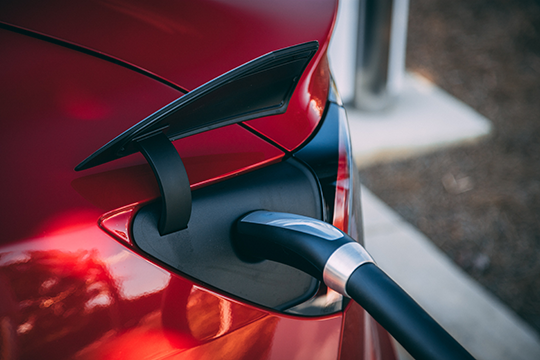编者按:本文部分内容来自NRDC专家Miles Muller在海口2021世界新能源汽车大会上的发言稿。
本博客作者:邹以宁
 @Vlad Tchompalov on Unsplash
@Vlad Tchompalov on Unsplash
中国已成为全球电动汽车保有量最大的国家并且仍在高速增长,其他国家的电动汽车保有量也在快速增长。随着电动汽车规模的进一步扩大,充电需求将对电网的平稳运行带来巨大影响。车网相连一方面带来了挑战,另一方面也带来利用电动汽车改善电网灵活性和提升电能服务质量的良机。本文介绍了如何通过车网协同(VGI)来挖掘电动汽车的经济潜力。
车网协同是什么?
首先来看车网协同的基本原理。电力系统的装机容量是按系统的最大用电负荷来规划设计的。也就是说,大多数时候,煤电、光伏等发电设备的利用率不到100%。而多数电动汽车一天中大部分时间都处在闲置状态,可以当作是带轮子的电池,从而发挥移动储能的作用。
因此,在用电需求较低且可再生能源充足时对电动汽车充电,可以提高电网的利用率并增加对新能源的消纳,即“填谷”;在用电需求较高且可再生能源不足时放电,可以降低用电尖峰时段的负荷,即“削峰”。此外,利用电动汽车“填谷”,即提高用电需求较低时的电网利用率,相当于通过增加售电量来分摊电网投资和运维成本,起到了降低电价的效果。
车网协同一般包括三种模式。第一种是有序充电(V1G)。当用电需求低、电网有剩余供电能力时可为电动车充电,当电力紧张时则减少充电。有序充电既可以手动完成,也可以让汽车或充电设备自动完成。第二种是车到家/楼(V2B)。使用电动汽车为家庭或建筑物供电,停电时可以作为建筑物的备用电源。第三种是车网互动(V2G)。在用电需求高、电力供应紧张时,电动汽车可向电网馈电,从而提高电网的灵活性,并作为灵活的需求侧资源参与需求响应而获取收益。又或者,在用电需求低、可再生电力供应充足时,电动汽车可以充电储能,更多地利用清洁能源。
车网协同的经济潜力有多大?
美国和中国的最新研究均显示,车网协同能创造的经济效益十分可观。斯奈普斯能源经济学咨询公司(Synapse Energy Economics)的研究证实,电动汽车在用电需求较低时段充电、为电网“填谷”,的确能够降低供电成本,最终降低用户电费。该研究基于美国电动汽车用户数量最多的两家电力公司的数据,对比了电动汽车充电给电力公司带来的收入和为电动汽车充电所需的能源成本、配电和输电网升级的相关成本,以及部署充电站的成本总和。研究发现,2012-2019年期间,电动汽车用户给电力公司带来收入比相关支出高出约8.06 亿美元。
美国许多州都实行了收入脱钩(revenue decoupling)机制。在这种机制下,电力公司等公用企业的收入与销售量相脱离。上述两家电力公司因电动汽车充电多得到的8亿多美元收入将在下一轮电价调整中体现,即将收益通过降电价的形式回馈给电力公司所有的用户,从而减少用户的电费账单。
劳伦斯伯克利国家实验室(Lawrence Berkeley National Laboratory)和太平洋天然气和电力公司(Pacific Gas & Electric)的研究表明,一些简单的智能车网整合政策,例如将电动汽车充电时间转移到非高峰时段,就可以让电网在无需大规模升级的前提下适应高电动汽车渗透率,减少75%配电网的升级需求。 劳伦斯伯克利国家实验室的另一项研究表明,电动汽车的确可以发挥移动储能的作用。该研究估算,电动汽车仅采用有序充电模式(部署相关设备的成本低于 1.5 亿美元)就可以为加州提供 1GW 的储能容量,在低成本下帮助加州实现三分之一的储能目标,并为电力用户节省开支高达15 亿美元。NRDC与国家发改委能源研究所和中关村储能联盟合作的研究也发现,电动汽车可以通过有序充电、V2G、退役电池储能等方式,经济高效地为电力系统提供储能或相似应用价值。
如何推进车网协同?
尽管创造的经济价值如此可观,而且车网协同的原理听起来似乎很简单,但车网协同的实施并非易事。一个主要原因是推动电动汽车与电网协同发展涉及多个部门、多种技术和电网服务。在某种程度上,车网协同的推广难度恰恰在于它的涉及面如此之广,难以单凭一种手段将其变为现实。为推动车网协同,需要促进部门之间的沟通协调、改进完善现有政策并适时推出新政策,引导对新技术进行投资,还要提高电动汽车用户对车网协同益处的认知。
NRDC在中国致力于推动电动汽车作为需求侧资源,帮助电网提高灵活性、可靠性和运行效率,促进可再生资源消纳,从而推动电力部门实现经济性的低碳转型。今年,NRDC与国家发改委能源研究所合作完成了《车网互动发展趋势及政策体系》,总结分析了2019年以来国内电动汽车与电网互动的试点项目,并基于案例分析评估可再生能源与电动汽车协同的效果,在设施标准、电价政策、市场机制及用户引导方面提出了相关建议,包括制定更加灵活的充放电价格机制 、电动汽车参与辅助服务市场、完善电池质保以提升车主参与等。报告还建议, 力争到“十四五”末期形成5亿千瓦以上的电动汽车灵活调节资源,这一规模将远超届时抽水蓄能装机规模。
同时,为了更好地调动终端用户积极性,NRDC也支持中国电动汽车百人会完成了国内首份车网协同的用户手册——《电动汽车与电网协同能力建设指南》,推动车网协同参与主体的多元化,提出实用、可操作的用户侧参与策略,实现电动汽车作为电网灵活性资源的价值。


